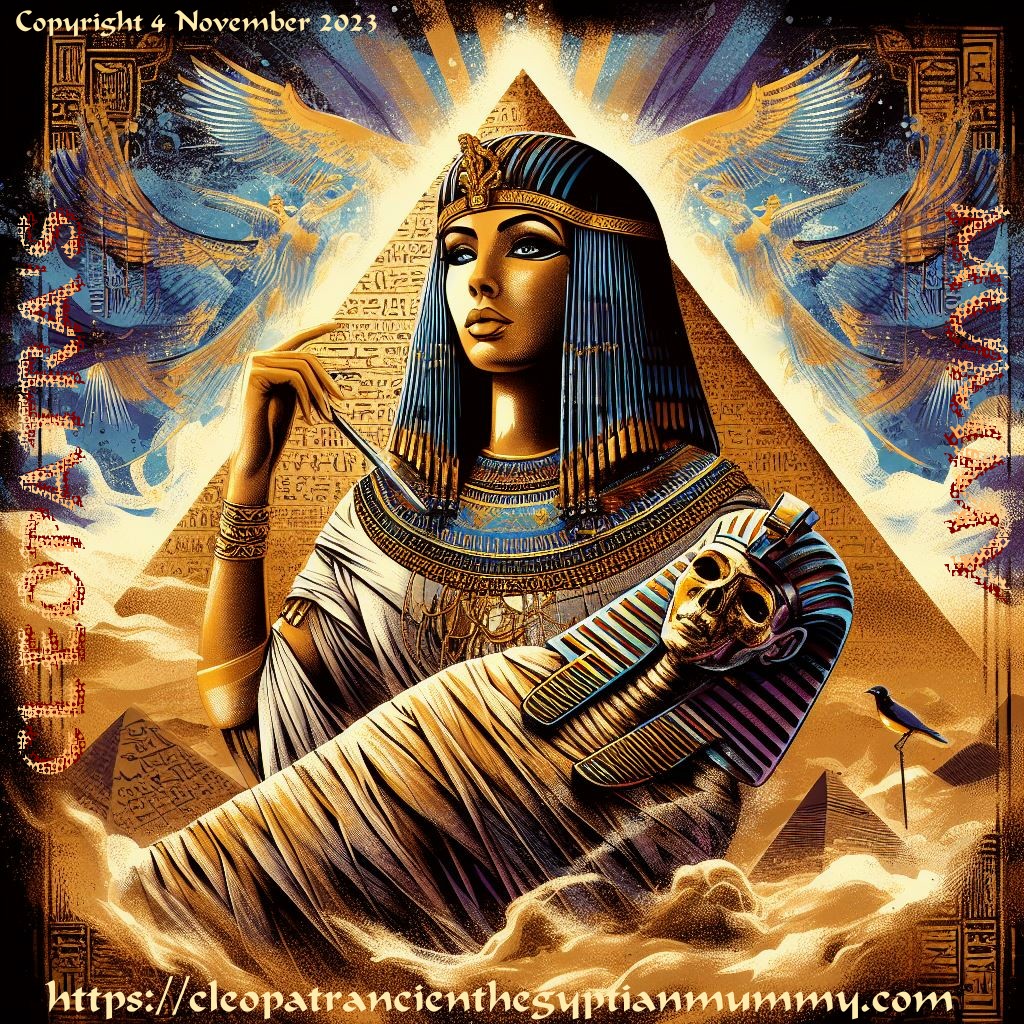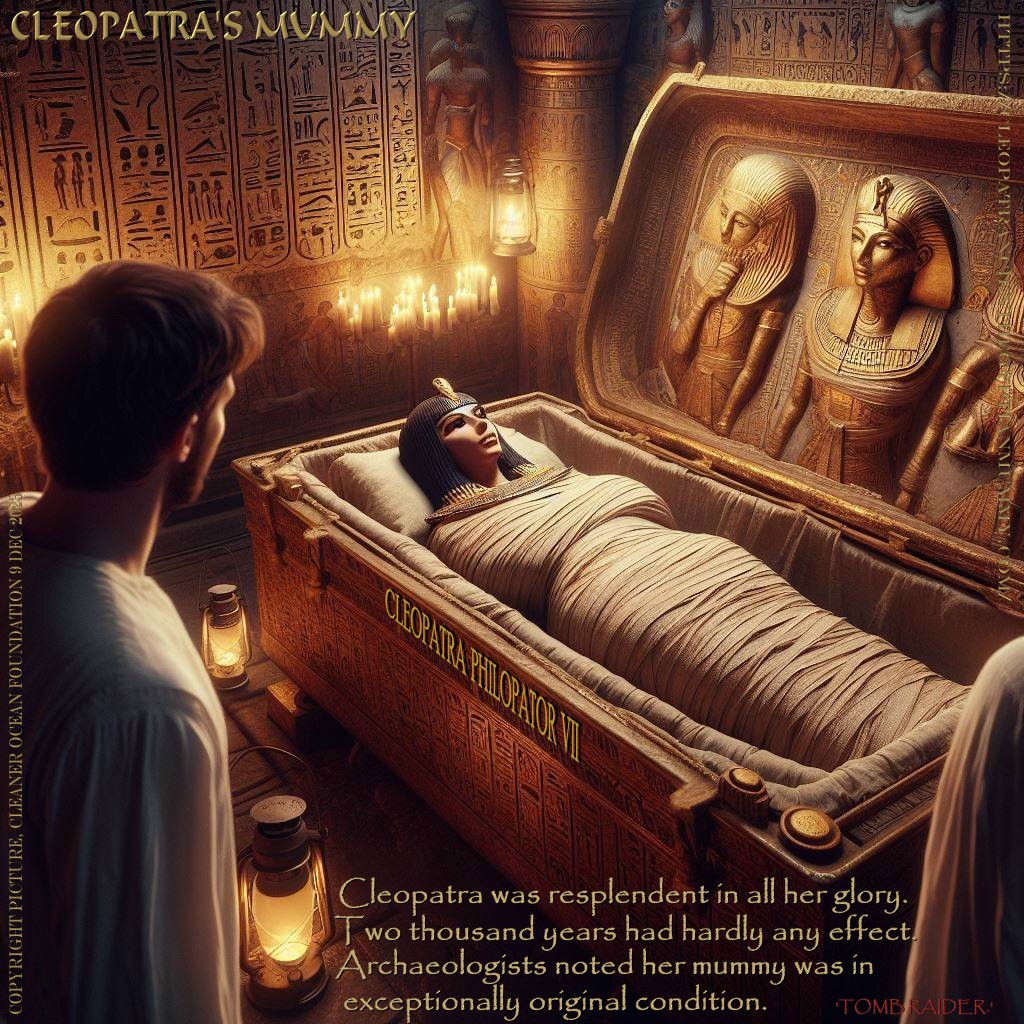|

There
is a script where Cleopatra is found by German and Swiss scientists, who
use the DNA from her mummy to reincarnate her, including conditioning the
brain of the replicant, or clone. This is a fascinating prospect, based on
real advances in cloning and replication technology.
Cleopatra VII Philopator was a fascinating and complex figure whose legacy continues to captivate us today. Here's some information about
her that is inspirational.
LIFE AND REIGN
The last pharaoh queen of Egypt was born in 69 BC, Cleopatra VII was the last active ruler of the Ptolemaic dynasty, a Hellenistic dynasty founded by Alexander the Great's general Ptolemy I Soter.
Cleopatra was known for her intelligence, political acumen, and multilingualism. She spoke Egyptian, Greek, Aramaic, Latin, and possibly other
languages, thought to total 11 in all. Her reign was marked by political struggles, alliances, and betrayals. She famously formed alliances with
Julius Caesar and Mark Antony, with whom she had children.
After the Battle of Actium in 31
BC, Cleopatra and Mark Antony were defeated by Octavian (later Augustus). Both committed suicide, marking the end of Ptolemaic rule and Egypt's incorporation into the Roman Empire.
LEGACY
Cleopatra is often remembered for her beauty and romance with Julius Caesar and
Mark
Antony, but she was also a skilled ruler who fought for her kingdom's independence. She was a patron of the arts and sciences, and her reign saw a flourishing of
Egyptian culture. Her life and death have inspired countless works of art, literature, and film, solidifying her status as a cultural icon.
INTERESTING FACTS:
- Cleopatra was the first woman to appear on an ancient Egyptian coin.
- She commissioned the translation of the Great Library of Alexandria's works into Greek.
- Her death remains shrouded in mystery, with theories ranging from snakebite to poisoning.
QUEEN
OF THE NILE
Cleopatra VII was often called the "Queen of the
Nile" for several reasons:
1. Connection to the Nile:
The Nile River was the lifeblood of ancient Egypt, providing transportation, water for irrigation, and supporting fertile land for agriculture.
As the Queen of Egypt, Cleopatra held immense power and controlled resources heavily reliant on the Nile. Her influence and prosperity stemmed directly from the river, creating a strong association between her and the Nile.
2. Political and Religious Significance:
The Nile was often perceived as a deity in ancient Egyptian mythology, associated with fertility and abundance.
By being linked to the Nile, Cleopatra gained additional legitimacy and divine stature in the eyes of her people. It symbolized her connection to the land and its divine blessing.
3. Cultural Representation:
The Nile River figures prominently in Egyptian art, literature, and mythology. Cleopatra was often depicted in imagery connected to the Nile, like riding on a barge or offering sacrifices to the Nile god. This visual representation further ingrained the association of Cleopatra as the "Queen of the Nile" in popular culture.
4. Literary and Historical Portrayal:
Early historical accounts and later literary works about Cleopatra, like Shakespeare's plays, often referred to her as the "Queen of the Nile." This repeated portrayal solidified the title and helped to shape her popular image across generations.
The title "Queen of the Nile" not only reflects Cleopatra's political power base but also highlights her symbolic connection to the lifeblood of Egypt and its cultural significance.
LAST
RESTING PLACE
The mystery of Cleopatra's final resting place has captivated
archaeologists and historians for centuries. There are several possible reasons why her tomb, and possibly her
mummy, haven't been
discovered yet:
Destruction and Disruption:
- Roman Era: After Cleopatra's death, Egypt became a Roman province. Subsequent rulers and citizens might have looted or even destroyed her tomb for its
treasures or out of animosity towards her legacy.
- Natural Disasters:
Earthquakes and floods are common in the region, potentially damaging or burying the tomb over time.
- Urban development: The modern city of Alexandria, built over ancient Alexandria, could cover Cleopatra's tomb beneath layers of buildings and infrastructure.
Challenges in Identifying the Tomb:
- Lack of clear historical records: Detailed accounts of Cleopatra's burial are absent, making it hard for archaeologists to pinpoint the exact location.
- Misinformation and conflicting theories: Numerous theories about the tomb's location exist, each requiring careful investigation and potentially leading to dead ends.
- Difficulty excavating in urban areas: Digging within a modern city presents logistical and legal challenges, requiring permits and careful
navigation around existing structures.
Current Areas of Focus:
- Taposiris Magna: Archaeologist Kathleen Martinez has been excavating this temple complex west of
Alexandria since 2005, believing it might house both Cleopatra and Mark Antony's tombs. Recent discoveries like a tunnel system have fueled optimism.
- Temple of
Osiris: Some theories suggest Cleopatra might have chosen this location near her palace in Alexandria, but extensive urban development makes excavation difficult.
- Underwater Exploration: Areas around Cleopatra's palace lie submerged, requiring specialized techniques and resources, but could hold clues if she was buried near the
water.
Future Considerations:
- Technological advancements: New ground-penetrating radar systems and other tools might offer better detection capabilities in complex environments.
- International collaboration: Sharing knowledge and resources between research teams could accelerate progress.
- Community involvement: Local knowledge and historical accounts can guide archaeologists towards promising areas.
Finding Cleopatra's tomb remains a complex challenge, but ongoing research, meticulous excavation, and innovative technologies might finally unlock this historical puzzle.
Success might hinge on a combination of factors, including luck, technological advancements, and a thorough understanding of the historical context.
Most
important of all, is to continue to seek this most valuable of Egyptian archaeological
treasures.

https://
|

